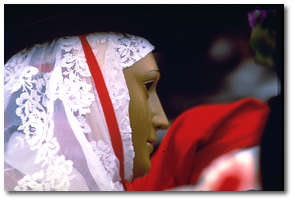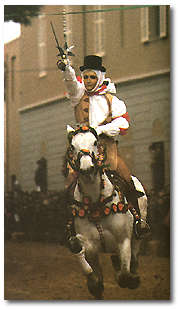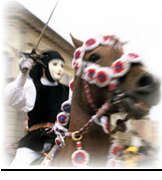The drums roll incessantly, the horseman
wears the mask of a mysterious God and he draws his sword holding it straight in front of him. The
horseman stands up on his saddle while he is galloping at breakneck speed along the road. After a
few seconds, the rumble of the crowd accompanies the point of the foil which pierces the star.
It’s done. People hail "Su Cumpoidori" and rejoice in front of the trophy
which is proudly paraded.
|
|
 |
This is the way that, on the last
Sunday and on the Tuesday of Carnival, Oristano becomes the capital of Sardinia. This is
the "Sartiglia", a festival of a thousand symbols, a festival of magic, of prosperity,
misery and of pain and hope.
|
 |
|
From Via S. Antonio as far as Via Vittorio
Emanuele and Piazza Mannu, a stream of people, who come from the four corners Sardinia, pass through
the Cathedral, throng the edges of the route which is covered in earth and straw. Each time this
festival takes place, centuries of history pour into that route which is trampled by the horses’
hoofs. A storm of screams and cheering accompanies "Su Cumpoidori" as his sword pierces the
star. Sartiglia is not a simple celebration of carnival rites, nor is it a reproduction of a Medieval
tournament nor an exhibition by brave strong horsemen. The Sartiglia is a collection of traditional
and cultural elements handed down over the centuries. The people in Oristano experience this festival
with indescribable emotive intensity. This festival, since the time of Giudicato d’Arborea,
has displayed some of the most interesting and as of yet unexplored aspects of pagan rites
influenced by Christian ceremony.
|
|



